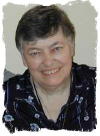
Sr. Hilda Frost OSB – "Reflections"
LECTIO DIVINA
As a child, Lectio Divina came naturally to me, having learned a love of the Bible from my Methodist father and my Congregationalist mother! Lectio Divina has a very long history, going back to the time of Jesus himself, who loved and taught from the Hebrew Scriptures. The Desert Fathers and Mothers of the 3rd and 4th century treasured the Word of God, as the basis of their prayer and spirituality. Cassian and others passed on this tradition to Benedict who centred his teaching on Scripture. So as followers of Benedict, Lectio Divina is a very familiar topic for all of us.
As Benedict suggests, the art of Lectio Divina begins with cultivating an ability to listen deeply to the voice of God who reveals himself to us through his Word in stillness and silence. There are various ways of doing Lectio. The 12th century Carthusian monk Guigo's 'method' of Lectio, meditation, oratio, and contemplatio is well known to us. Alternatively we can just select a short passage of Scripture; allow it to touch our hearts; and ask for God's help to live it out in our daily lives. My own approach is simple.

Sr. Hilda Frost OSB – "Reflections"
LECTIO DIVINA
As a child, Lectio Divina came naturally to me, having learned a love of the Bible from my Methodist father and my Congregationalist mother! Lectio Divina has a very long history, going back to the time of Jesus himself, who loved and taught from the Hebrew Scriptures. The Desert Fathers and Mothers of the 3rd and 4th century treasured the Word of God, as the basis of their prayer and spirituality. Cassian and others passed on this tradition to Benedict who centred his teaching on Scripture. So as followers of Benedict, Lectio Divina is a very familiar topic for all of us.
As Benedict suggests, the art of Lectio Divina begins with cultivating an ability to listen deeply to the voice of God who reveals himself to us through his Word in stillness and silence. There are various ways of doing Lectio. The 12th century Carthusian monk Guigo's 'method' of Lectio, meditation, oratio, and contemplatio is well known to us. Alternatively we can just select a short passage of Scripture; allow it to touch our hearts; and ask for God's help to live it out in our daily lives. My own approach is simple.
Like the Desert Fathers and Mothers who used to ask their 'mentor' for 'a word' or 'a word of wisdom' for that day, I ask Jesus for a word from Scripture to carry with me throughout the day to inspire, strengthen and encourage me. Usually a word or phrase from a chosen passage will stand out for me, and remain in my heart for the rest of the day.
Of course Lectio Divina is not intended to replace meditation, but rather to enhance it and build up our spiritual life. In his talks to Benedictine Oblates John Main often spoke of the importance of Lectio Divina. "St. Benedict saw Lectio as an integral part of our Christian living….the purpose of Lectio is not the acquisition of knowledge.
Benedict's Lectio is another exercise in self-transcendence. The monastic/oblate is not trying to possess what they study but use their study to help them respond to the presence of God…A loving reading and reflection upon the Word of Scripture is, in Benedict's vision, essential in forming the monastic as a person of prayer." ('Community of Love' p. 131-132).
Laurence Freeman has this to say: "Take as short a piece of Scripture as you possibly can – just a few verses…Simply read the verse and remain with it, repeating it, reflecting on it, letting it sink into your heart and into your mind…Slow down and read the verse or the few verses that you choose as attentively and as repetitively as you can (Aspects of Love p.32) Meditation sends us back to the words and images of sacred Scripture, not only our own Scripture but indeed ALL Scriptures. When I listen to the word of God in Scripture, do I attend to the words and hear them as if for the first time? Do I respond to the Word with an open heart? (Aspects of Love p.87).
Fr. Bede Griffiths talks about Lectio Divina as an essential part of monastic prayer. 'A traditional way of monastic prayer is Lectio Divina; the meditative reading of the Bible. This is an excellent practice and fundamental.' ('The New Creation in Christ' p. 9). He speaks convincingly of the need for meditation to be supported by Lectio. 'We need this support all the time… it is necessary to meditate on the Scriptures, and to learn to understand the mystery of redemption' ('The New Creation in Christ' p. 44).
These are but a few thoughts on Lectio Divina. More important still is not only to read about it but to actually do it! Our daily Lectio will support our meditation; sustain us on our spiritual journey, and help us in our daily life.
Much love,
Hilda OSB
Sr. Hilda is a Benedictine Sister at St. Benedict's Monastery, Winnipeg Canada. She comes from a very ecumenical background: with a Methodist father, a Congregationalist mother, who attended the Anglican Church in England. After attending a convent school Sr. Hilda became a Catholic, and entered the cloistered Benedictines in England. When the community became diminished and eventually had to close she came to Canada in l981. Sr. Hilda has a background in Scripture, monastic history etc. and has been a meditator for more than 20 years. She has given retreats and workshops on the Rule of Benedict, the mystics, as well as on Christian meditation. She is coordiantor of the WCCM Oblates in Canada, and also leads a meditation group in her own monastery.



